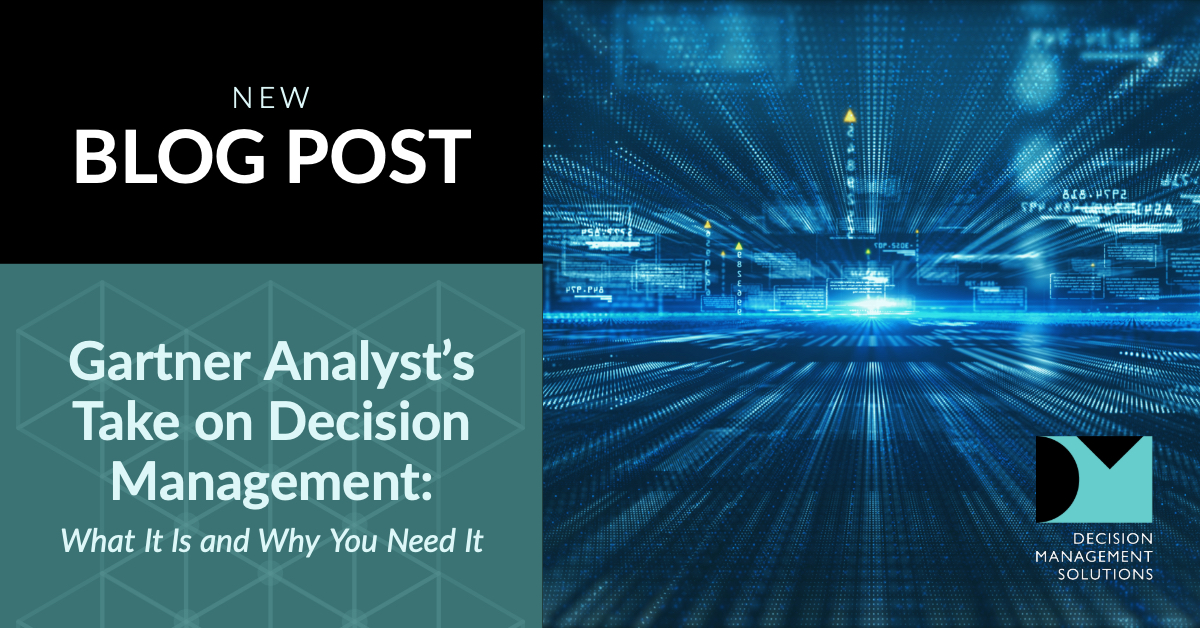February 20th, 2019 W. Roy Schulte, Research Vice President and Distinguished Analyst at Gartner gave an interesting webinar titled, “Decision Management: What It Is and Why You Need It.” Roy kicked off the webinar by stating that “companies make millions of operational decisions every day,” and how well (or not) they make these decisions is directly correlated with the business thriving (or not). He described the types of complex operational decisions being addressed, such as next best offer (NBO), product configuration, or approving an application, such as for a credit product.
The world of decision management is changing. For decades we’ve had three major disciplines each doing something different about improving the quality of decisions.
- Business process management (BPM) and application development teams using rule engines and embedding business logic into the business processes and into the application systems
- Analytics and data science teams producing data science models and reports to help people make better decisions
- Management science teams, also called operations research teams, use sophisticated mathematical techniques, such as optimization to find the best available solution in complex decision scenarios.
Gartner asserts that these disciplines are starting to overlap more and more, creating new opportunities for companies and government agencies to improve their decision making. Many of the elements of these three distinct disciplines have and should be extracted and combined to create the new and separate discipline of decision management.
The three main topics covered in the webinar are:
- “What is decision ‘modeling’ and where does it apply”
- “How do you choose the right analytics”
- “What are the best practices for deploying analytics into operations”
“What is decision ‘modeling’ and where does it apply”
Decision modeling is an essential blueprint for the discipline of decision management. Sometimes it’s easier to understand it, by stating what it’s not. It’s not data modeling. Nor is it analytics modeling or business process modeling. Decision management is the discipline of designing and building systems that produce structured decisions. It can also be called digital decisioning. These systems may implement decision automation or decision support, meaning without any or including some human participation in the decision.
A decision model is an abstract representation of a decision-making process, including at a minimum a description of the input data, a description of the algorithm (i.e. the recipe including the rules, analytics, and logic applied to the input data), and the output – the judgment, determination, or action to be taken. Some decision models also document objectives, constraints, and participants contributing to the decision. There are often many sub-decisions involved.
“How do you choose the right analytics”
The analytics technology to use for decision making is very important, but sometimes it’s hard to know how to select the right one for a given situation. Companies make many different kinds of decisions and different decisions require different technology. Decision management is generally most effective in operational, non-trivial decisions.
We can categorize the types of analytic technologies used for making decisions into three main techniques: data science and machine learning (ML), business process management (BPM) and computational logic, management science and optimization. Data science and ML is based on probabilistic logic, when you have lots of historical data that you can rely on using techniques such as regression, clustering, neural networks, decision trees, Bayesian networks, etc. BPM and computational logic include techniques such as logic programming, business rules management (MRM), rules-based systems, heuristics, fuzzy logic, etc. Management science and optimization includes techniques such as constraint-based reasoning, linear programming, genetic algorithms, etc.
It is appropriate to use one of more of these techniques together to solve a problem, particularly when many sub-decisions are present in the decision model. Analytics vs. rules is a false choice. In cases such as compliance, age limits, or eligibility criteria, rules are often a much a better choice and can be used in combination with analytics in other parts of the decision model. For example, when a credit score is used in a decision model. The output of the analytics becomes an input to the greater decisioning system.
“What are the best practices for deploying analytics into operations”
Here are the three of many best practices in modern decision management:
- Use decision management for high-value, non-trivial decisions. The most fundamental best practice is to recognize situations where it makes sense to take a systematic approach to decision making. There are many simple decisions companies make everyday that are not made significantly better through a systematic approach to decisioning making. A customer orders a pair of running shoes. The order is sent to the sporting goods department. However, for more complex decisions involved in decisioning mortgage applications, insurance underwriting, complex pricing or product configuration, where there are multiple types of data, decision criteria, policies, and a lot of trade-offs, these situations benefit richly from decision management.
- Start system design with some form of a decision model. This means starting at the decisionand working backward to see how you get there. Start by working with subject matter experts (SMEs) to develop the conceptual decision model. This model gives the overall guidance on what types of models need to be built and helps figure out which analytics technologies are appropriate to solve their particular decisioning need.
- Track input, decisions, and results to enable “continuous” decision improvement. As things change in your marketplace, you’ll want to adjust how decisions are made. To start, you need to collect data as the process is underway, such as input transactions, components used to make the decisions, and business outcome, such as whether an offer is accepted. This data is stored and represented in the decision dashboard, and can be used to retrain models and update rules, over time.
To learn more of the details presented at this webinar, watch the webinar on demand.
